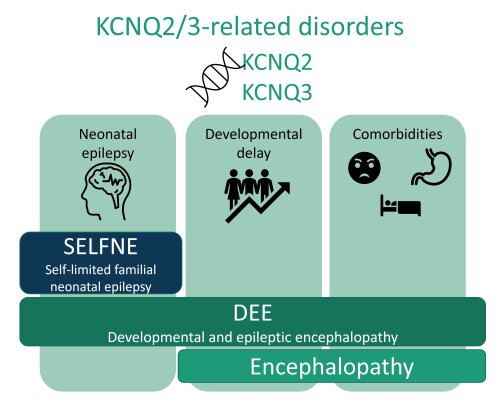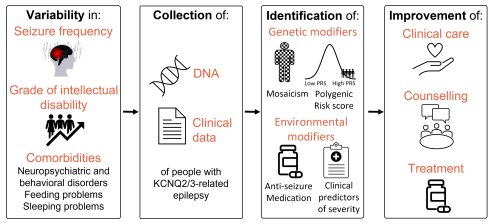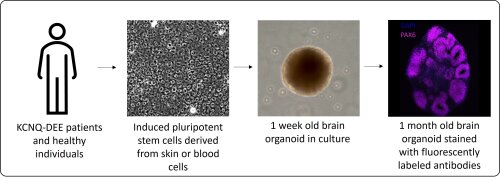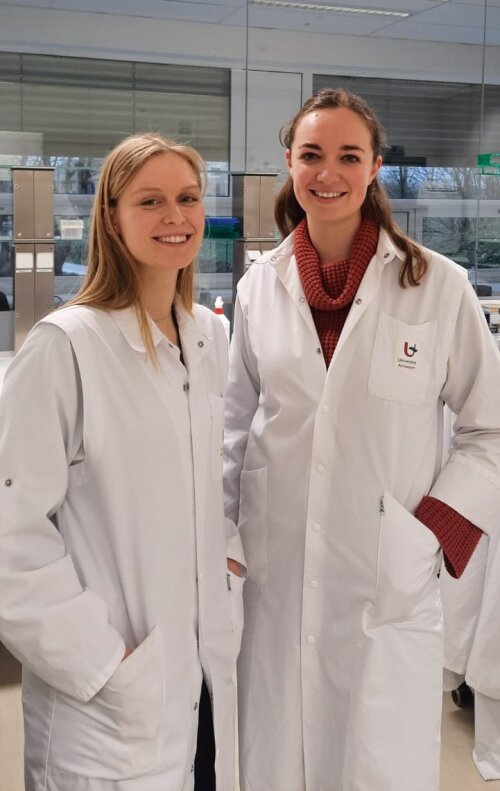KCNQ2/3-related epilepsy research: from bench to bedside and back
KCNQ2- and KCNQ3-developmental and epileptic encephalopathy (DEE) are characterized by epilepsy and severe neurodevelopmental delay and are caused by genetic mutations in the KCNQ2 or KCNQ3 genes. KCNQ2/3-DEE starts in the first weeks of life, and since no treatments are available that significantly improve the neurodevelopmental outcome, they greatly impact patient’s and caretakers' quality of life.

Since our group described KCNQ2-DEE in 2012 for the first time (Weckhuysen et al, 2012), one of the main interests of the Weckhuysen lab is studying the underlying molecular and cellular mechanisms of KCNQ2/3-DEE to be able to develop novel targeted treatments. Therefore, we study KCNQ2/3-DEE in human patients, as well as neuronal cell and rodent models.

(Figure created using Biorender.com)
Identification of genetic and environmental modifiers that influence outcome in KCNQ2/3-DEE.
There can be considerable differences in the severity of the KCNQ2/3-DEE, even between two people with the same mutation. One of the possible reasons is that several additional genetic and environmental variations (modifiers) further influence the risk and severity of epilepsy and developmental delay in individuals with a known mutation in the KCNQ2 or KCNQ3 gene.
The aim of this study is to look for these underlying factors (modifiers). A better understanding of factors that play a role in the risk and severity of epilepsy and developmental delay is essential to better inform patients and their parents about expected health problems, and to develop improved medication against this condition.

Unravelling the disease mechanisms of KCNQ3 Gain-of-Function Encephalopathy using "mini-brains in a dish"
KCNQ3 Gain-of-Function Encephalopathy (KCNQ3-GoF-E) is a subtype of KCNQ2/3-DEEs in which patients are mostly affected by neurodevelopmental delay and less by epileptic seizures. However, the origin of the developmental delay that occurs in KCNQ2/3-DEEs remains least understood.
Therefore, we study KCNQ3-GoF-mutations in a 3D cell culture derived from human induced pluripotent stem cells (iPSCs), called brain organoids ("mini brains in a dish"), to focus on underlying disease mechanisms. These brain organoids grow in a petri dish in the lab and have the capability to mimic embryonic brain development.
While research on neurological disorders used to be centered around neurons (the fundamental units of the nervous system that pass on signals through electrical pulses), evidence shows that microglia (the brain’s immune cells) also play an essential role in neurodevelopment and disease pathways. Therefore, we are currently optimizing a method to include these microglia in our brain organoids.
Once established, the organoids will be studied on different levels using microscopy, electrophysiology, and transcriptomics to create a better understanding of how KCNQ3-GoF-mutations cause disease and to find new biological targets to treat patients.

Study the impact of (novel) therapies for KCNQ2-DEE via disease-specific imaging changes
In KCNQ2-DEE, we aim to develop novel treatments that improve seizures, as well as neurodevelopmental outcome. Although the effect of novel drugs on epilepsy is easily measurable (e.g. electroencephalogram (EEG)), the effect on neurodevelopment is more difficult to study.
Therefore, we use different imaging techniques (resting-state functional MRI (rs-fMRI) and positron emission tomography (PET)) in a KCNQ2-DEE mouse model to study disease-specific brain changes during neurodevelopment from infantile to adult age. In this way, we can explore when and where brain changes occur. These brain changes are “biomarkers of neurodevelopmental dysfunction”. These biomarkers can then be used to evaluate the effect of (novel) treatments on neurodevelopment.

Written by Noortje Zonnekein and Charissa Millevert

PhD students Weckhuysen Lab
Translational Neurosciences / VIB-CMN Applied & Translational Neurogenomics



